Understanding, measuring, and improving sales performance: Your ultimate guide

Director of Sales Development at Dialpad

Tags
Share
Achieving optimal sales performance is tough in any sales org. Between ramping up new reps, aligning with marketing and revenue teams, and dealing with the ever-changing competitive landscape, leaders have their work cut out for them.
Having led our team of midmarket SDRs for a few years (and working at an Ai company that’s building a product designed specifically to empower sellers to close more deals), we’ve picked up a few innovative ways to level up sales performance. In this guide, I’ll delve into how our sales team operates, lower-effort ways to measure sales performance, and actionable strategies for sales performance management.
Let’s dive in.
Copy-paste your best seller
Dialpad's Ai Playbooks give you the tools to help all your reps be like your best rep.
What’s meant by “sales performance”?
Sales performance is, at its core, simply the effectiveness and efficiency of a sales team in achieving its objectives and targets.
It's not just about closing deals—it can also encompass various other factors like revenue generation, sales cycle length, market share expansion, and overall customer lifetime value. In a high-performing sales org, sellers are consistently exceeding sales goals while also maintaining high levels of customer satisfaction and retention. Ultimately, it's both an art and science.
How to measure sales performance
There are different ways to measure sales team performance. If you ask an executive, they’ll probably mention common metrics such as revenue, pipeline, and leads generated. But for a sales leader, there’s more to measuring sales performance than just tracking a few numbers.
Quantitative metrics
The most common way to measure sales performance is, of course, to use key quantitative indicators such as revenue generated, sales growth rate, conversion rates, and average deal size to gauge the overall performance of your sales team. These numbers provide concrete, tangible insights into your sales team's efforts and effectiveness in driving revenue.
Qualitative assessments
But numbers rarely tell the whole story—you have to look beyond the numbers as well. In addition to quantitative metrics, sales leaders should also assess qualitative factors such as prospect and customer feedback.
We use Dialpad Sell, which helps us monitor sales team performance both live on calls and after the call. Sales managers used to have to sift through hours and hours of call recordings to check how sellers’ conversations went. It was either that or spot-checking by cherry-picking calls, which also wasn’t a good way to get an accurate sense of rep performance.
Dialpad Ai helps us with this because it can do sentiment analysis in real time, which lets me see instantly how all of my reps’ calls are going. If I see a call in negative sentiment territory, I can quickly open up the live transcript (did I mention Dialpad Ai also transcribes calls in real time?) to get the history of the call before deciding whether I need to jump in:
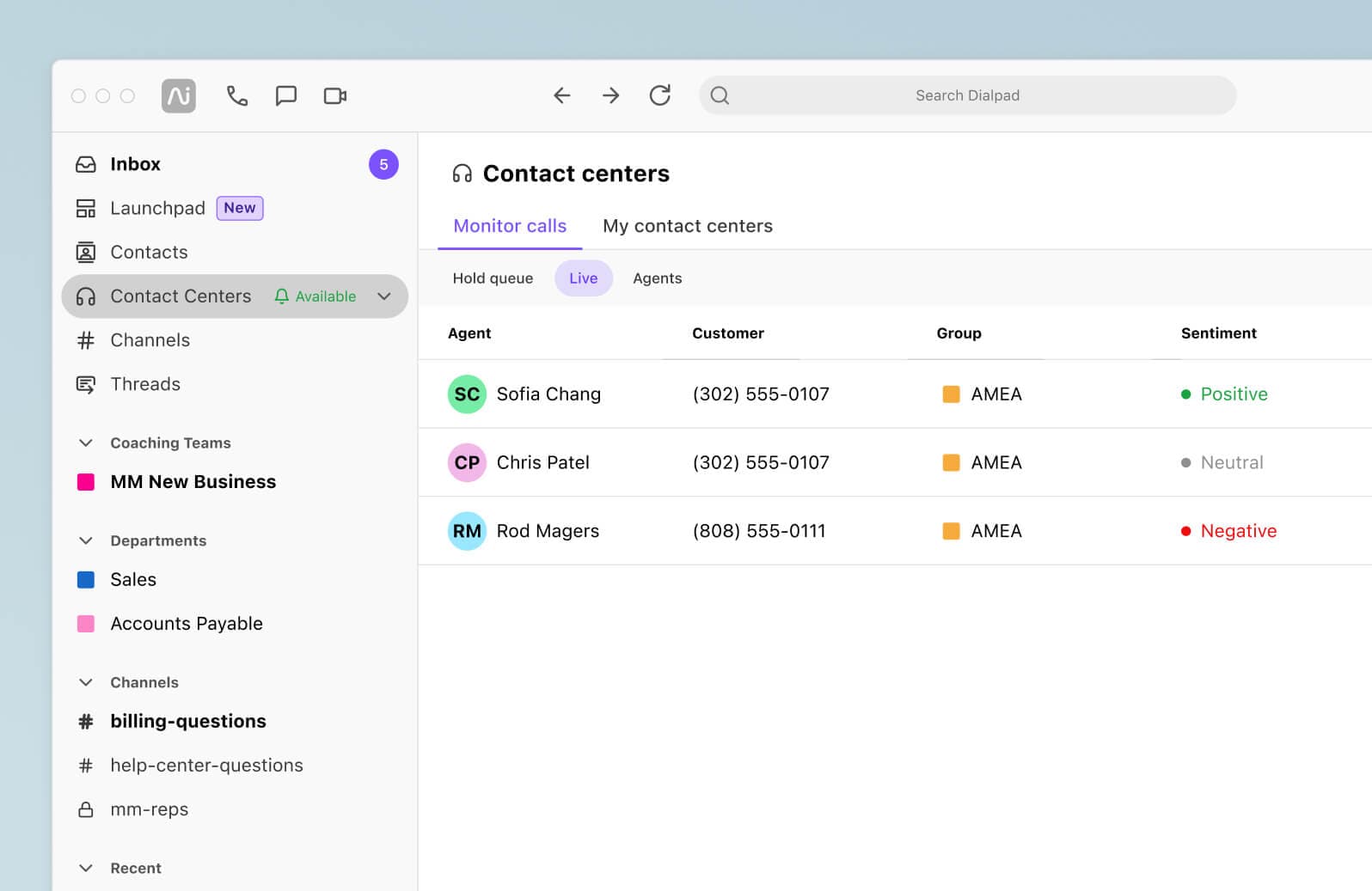
Another useful thing Dialpad Ai can do is detect and track when certain keywords and phrases are spoken on calls, and how frequently they come up in sales conversations.
For example, if I were interested in how proficient our SDRs are at booking demos or discovery calls, I can create a “Custom Moment” in Dialpad for “demo” and “discovery”:
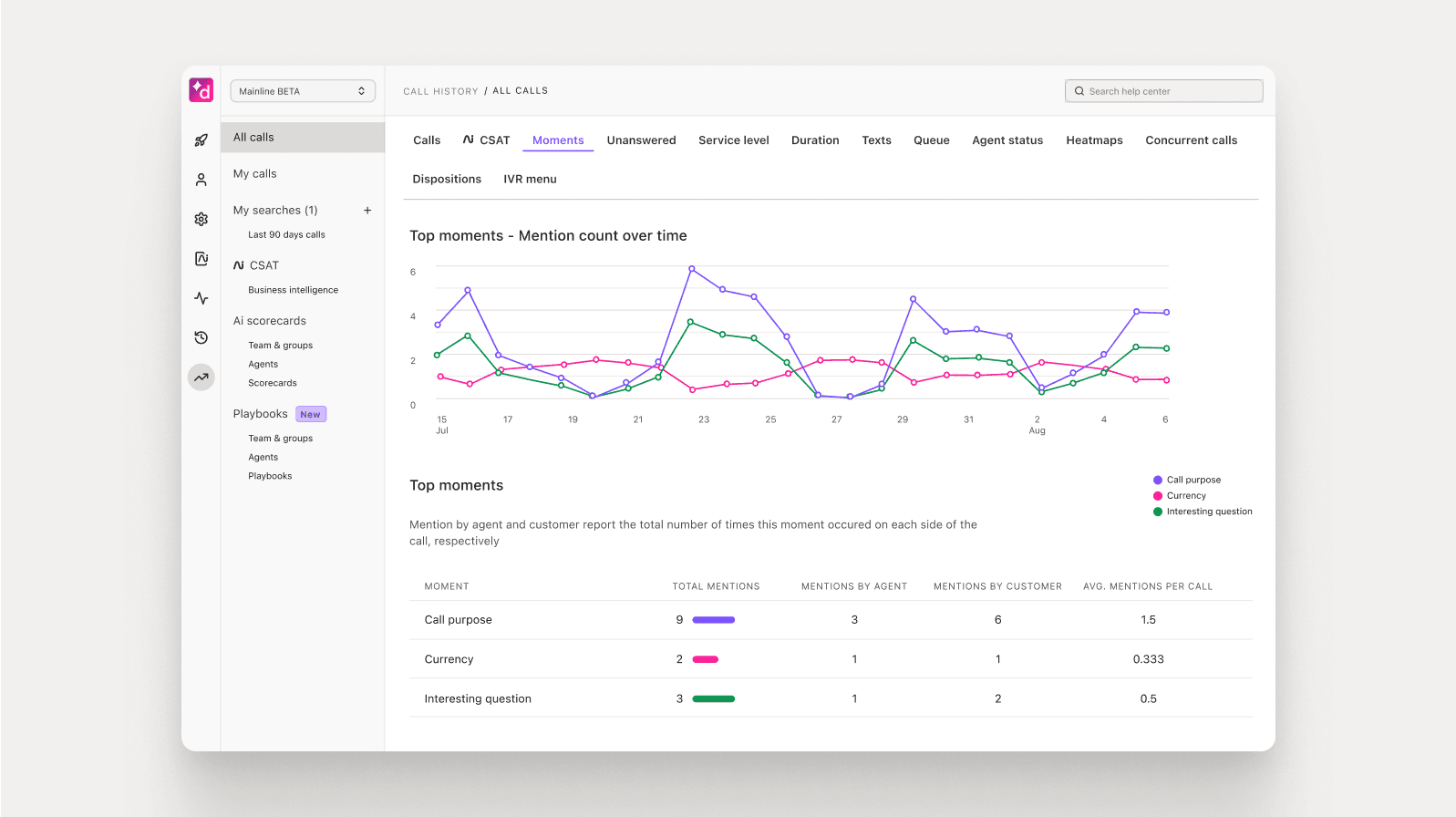
Dialpad Ai will then track when these keywords are said on calls, and I can then see these instances in my sales performance dashboard and open up those specific calls to see how those conversations go when reps try to schedule demos and discos.
Qualitative assessments do tend to be time-consuming. Instead of just scanning numbers, you often have to listen to (or read through) long conversations, just to check if reps are doing certain behaviors according to your sales methodology.
AI can help with that too. We use Dialpad's Ai Playbooks feature, which suggests questions or topics that reps have to run through in a sales call—and automatically checks them off so the rep knows they've successfully executed our sales methodology:
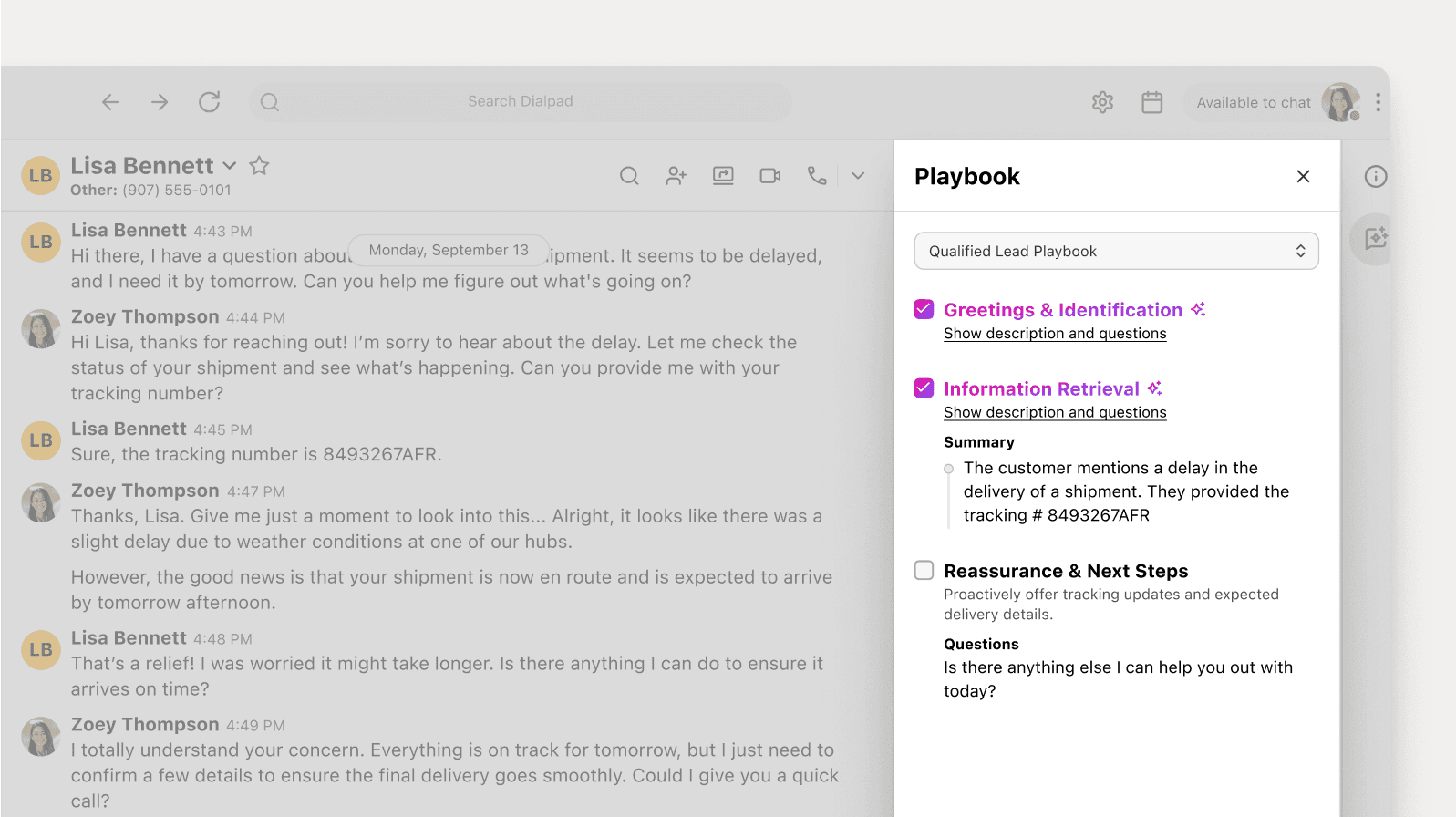
This is amazing, both for the rep and the manager, because it’s helping them self-correct in real time and it also helps us as managers save a ton of time because we don’t have to listen to a whole hour of a sales call anymore.
To take this one step further, Dialpad's Ai Scorecards can also review calls to see if sellers did everything listed on the scorecard criteria (basically your methodology’s requirements).
All managers have to do is create a QA Scorecard. Dialpad Ai will then “listen” to sales calls and automatically suggest when the scorecard behavior is met:
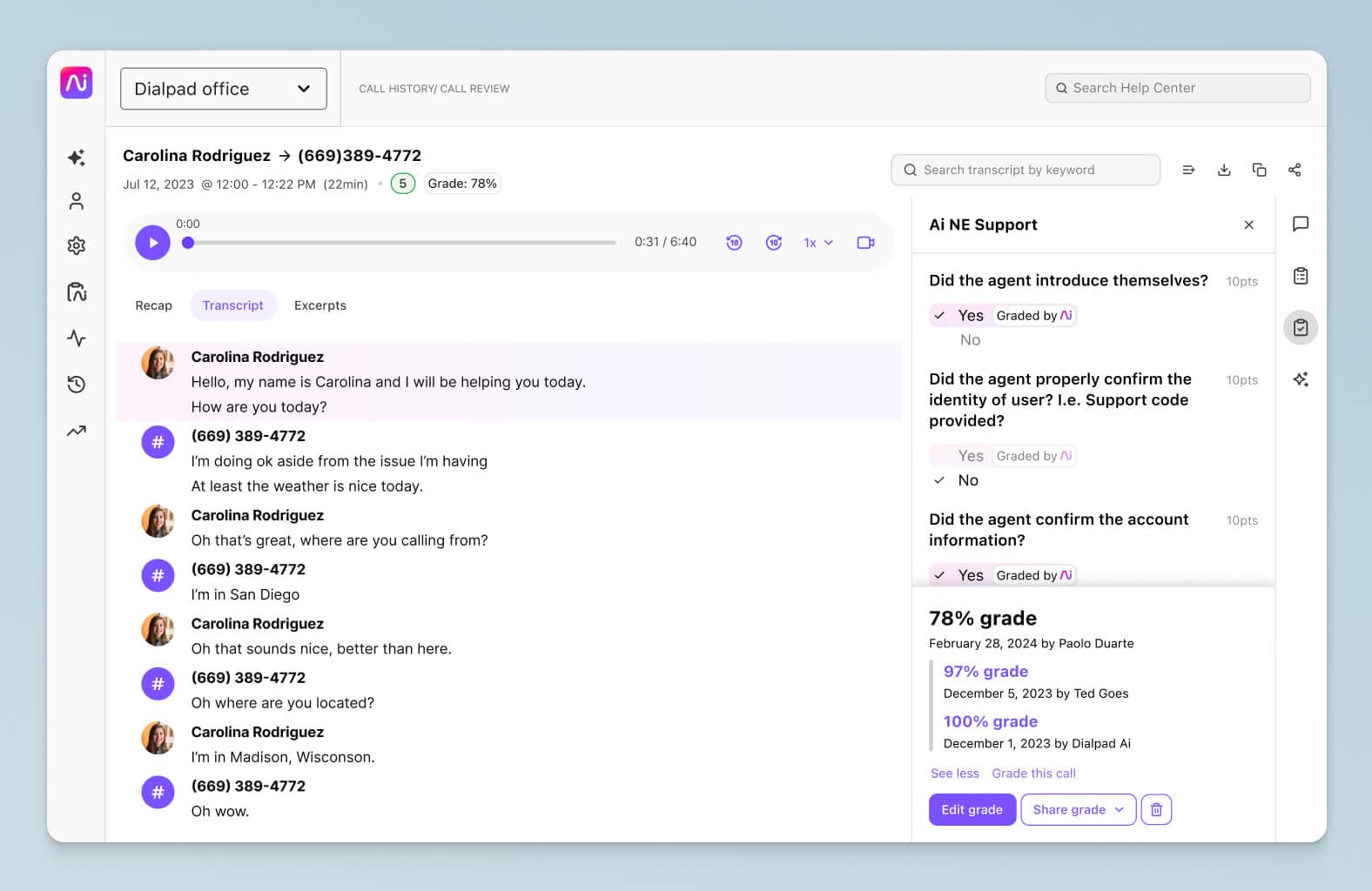
For example, you might add, “Seller asked prospect about timelines" to scorecard criteria. If the rep asks about timelines, whoever reviews that call will instantly see that this was done.
Useful sales metrics and KPIs to track
Conversion rate
One of the most important sales metrics is the conversion rate, which measures the percentage of leads that successfully convert into paying customers. Of course, this definition may vary a bit depending on if you’re a full-cycle sales rep or an SDR. Some reps may be measured on their closing ratio, while an SDR’s main conversion goal might be simply to get a prospect to agree to a meeting instead of closing the deal.
Besides improving training and development programs, there are a few ways to directly impact conversion rates. Ai helps us with this all the time.
Dialpad’s Ai Live Coach feature automatically pops up helpful notes and even links and media for our sales reps when specific keywords are spoken. Let’s say our AEs come up against Competitor “X” all the time in sales conversations.
Ai Live Coach will instantly search our connected knowledge bases (like our battle cards, PDFs, and even unstructured sources like past sales conversations) to surface helpful notes on how to position our brand against Competitor X.
This will then pop up on my reps’ screens whenever a prospect brings up Competitor X’s name on a call. This way, even newly hired reps can confidently handle questions and objections about almost every topic—which ultimately leads to higher conversion rates:
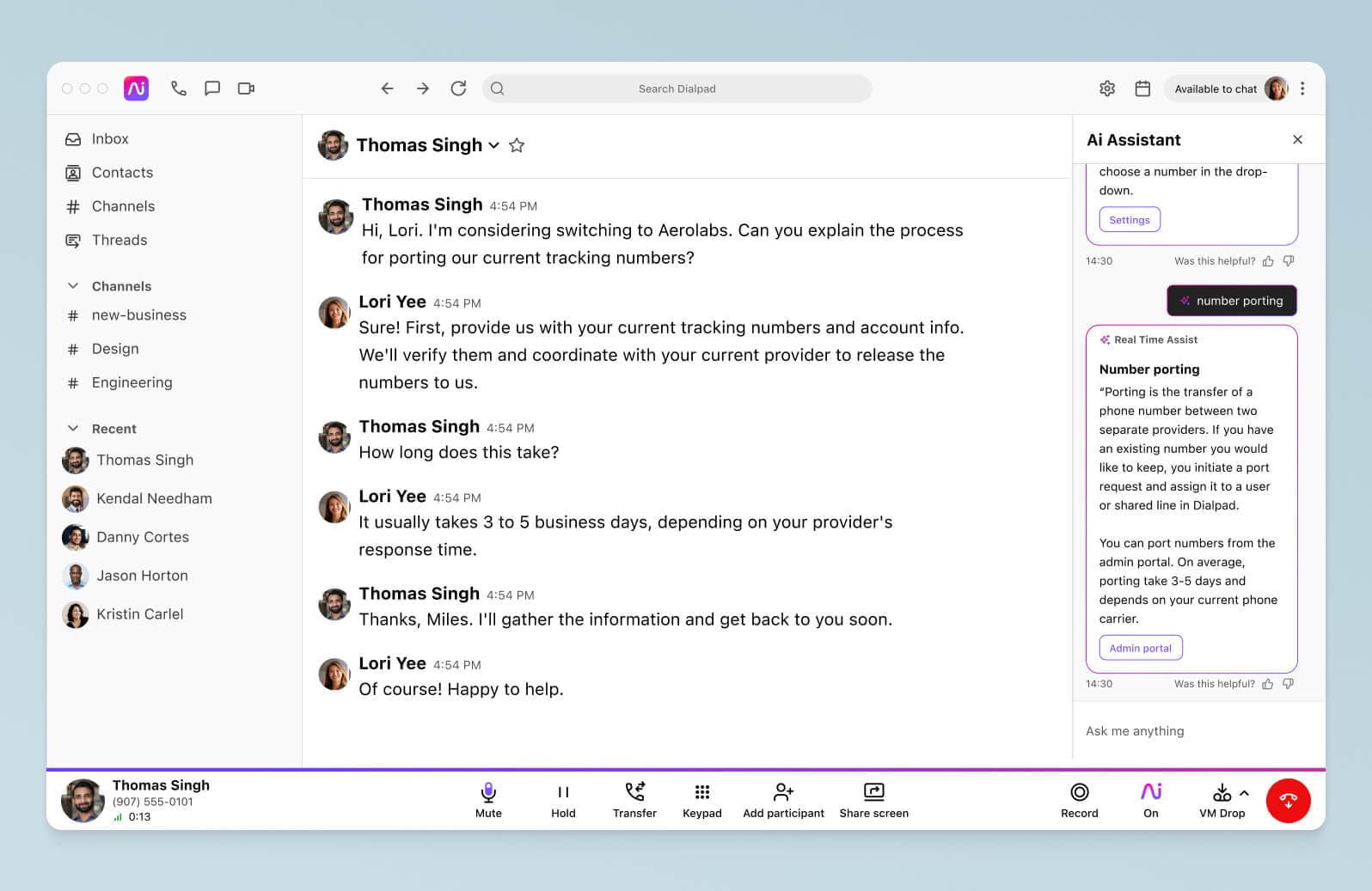
Sales velocity
Sales velocity is basically the speed at which deals move through the sales pipeline from initial contact to close. A higher sales velocity is generally better—we try to streamline processes and shorten sales cycles wherever we can. Moreover, using a sales pipeline template can help streamline workflows, ensuring each stage of the pipeline is clearly defined and optimized for maximum efficiency.
Customer Lifetime Value (CLV)
Your CLV is the total revenue generated from a customer throughout their relationship with your business. Understanding CLV is important because it helps you prioritize high-value customers and tailor your sales strategies accordingly.
Pipeline health
This is more of a broader measurement that encompasses a few metrics that is often shared in collaboration by both Sales and Marketing. Generally, you’d assess the health of your sales pipeline by monitoring metrics such as pipeline velocity, pipeline coverage, and stage conversion rates. Having a healthy pipeline will give you a consistent flow of opportunities and revenue.
Win rate
Your win rate is the percentage of opportunities that result in closed deals. A high win rate indicates effective sales strategies—your reps understand your customers and are aligned with prospects’ needs (and often, great product market fit as well).
Churn rate
Churn rate is something that generally impacts SaaS or subscription-based businesses only. It refers to the rate at which your customers stop doing business with you—within a certain period.
You want a low churn rate to maintain a stable customer base. Fun fact: It’s also possible to achieve negative churn, which is when new revenue from your existing customers is higher than the amount of revenue you’re losing due to customers canceling or downgrading their plans.
Dialpad tip:
Some people might think that churn sounds like something that matters more for customer support teams than sales teams, and that might be partially true. But a high churn rate can also suggest that your sales team is closing the wrong customers, who are quickly churning out after realizing that your product or service isn’t actually a good fit for them.
Sales cycle length
Sales cycle length is the amount of time it takes for a sales lead to progress from initial contact to closing a deal. It encompasses all stages of the sales process, from prospecting to negotiation and finalization. One of the most common ways to improve sales performance is to shorten the sales cycle length, which should lead to increased revenue generation.
Sales productivity
This is another metric that can be a bit blurry. Usually, “productivity” just means volume of sales activities. Here we’re trying to measure the efficiency of the sales team by tracking metrics such as calls made, emails sent, meetings held, and time spent on administrative tasks—usually on a daily, weekly, monthly, and quarterly basis.
How to improve sales performance
Here are a few tactics to incorporate into your sales performance management strategy, with tips spanning initial ramp time for new reps to on-the-call coaching and guidance.
1. Invest in continuous training and development
Products, services, competitors, and the industry itself are all always evolving. This is a given in SaaS, but we see this happening in many of our customers’ industries as well—even traditionally slow-moving ones like healthcare and law, which typically take a longer time to adopt and trust new technology.
That’s why you have to make sure you equip your sales team with the necessary skills, knowledge, and tools to excel in their roles. Provide ongoing training sessions, workshops, and mentorship programs to foster professional growth and development. These are all table stakes when it comes to managing sales performance improvement.
This is also something that Ai has helped us a lot with. Yes there are the usual sales enablement tools and repositories of information that we keep up to date with the latest sales battle cards and recorded trainings, but Ai has automated a lot of the high-effort live coaching that managers typically have to do.
Selling a new product? The Ai Live Coach will make sure it pops up a hint for reps in real time so they don’t have to manually go searching through databases and FAQs. (Both experienced reps and new hires benefit from this!)
2. Use Ai and automation to streamline sales processes
Once sales orgs get to a certain size, bloat is inevitable. Teams tend to have large tool stacks (with many apps collecting dust), methodologies get outdated, and so on.
It’s important to set a regular cadence of “checkups,” even if it’s once a year, to map out your current sales processes, all the way from lead generation to closing deals. Document each step including communication channels, tools used, and decision points.
Then you can analyze your sales processes more closely to identify bottlenecks and redundancies, and solve pain points your sellers are experiencing (whether that’s low conversion due to slow lead follow-ups or inefficiencies because of too many manual data entry tasks). In terms of low-LOE (level of effort) sales performance improvements, this is a top actionable piece.
Integrations can be a great help here. If you’re using any one of the major CRMs, they should have a wide range of integrations with other popular tools such as Google Workspace, Microsoft 365, and more.
Dialpad Sell integrates with most tools that sales teams use, which we love—not only does it embed a dialer right inside Salesforce:
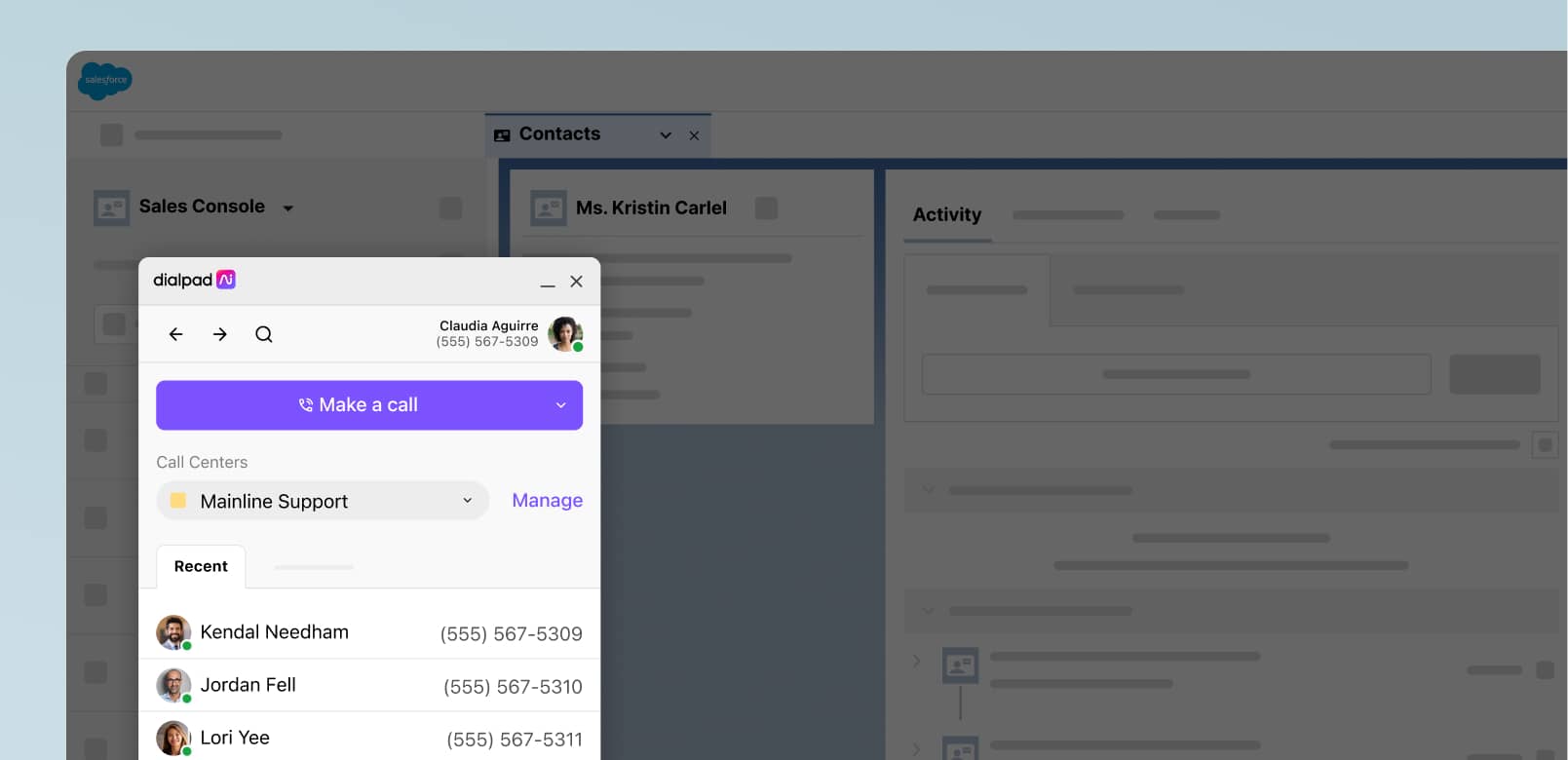
It also embeds Dialpad Ai right inside your CRM, so that reps can see things like call transcriptions and even Ai Live Coach Cards without having to toggle constantly between different tools.
3. Implement a data-driven approach
Sales teams have access to more data than ever before, which is good but also creates a major challenge: having to sift through that data. No one (at least no one I know) has time to do that, which is why sales automations and Ai tools are so important.
For sales teams, data is the secret weapon. By leveraging data, analytics, and sales intelligence tools, you can gain actionable insights into customer behavior, market trends, and sales performance metrics.
One of the best (and cheapest) sources of data? The sales conversations your team is already having, every day. So, when you’re evaluating sales performance, don’t just focus on metrics—look at the qualitative data and contextual information too.
4. Align sales and marketing efforts
Foster collaboration and alignment between your sales and marketing teams. Often, sales team performance isn’t just a result of all the sales orgs doing well—it’s directly impacted by Marketing. If Marketing isn’t bringing leads that are the right fit, or if new campaigns aren’t aligned with sales trainings, even the best sales teams won’t perform well.
5. Adopt a sales framework for your team to work within
This depends on the maturity of your sales organization and would require a broader conversation with your sales and GTM leadership team, but if your sales team doesn’t already have a sales methodology like SPICED or BANT, you might want to consider adopting one.
Having a framework empowers sellers in every team to have a consistent workflow (“What steps do they need to follow to push a prospect through the sales journey?” “What questions do they need to ask once they get a prospect on the phone?”), and by extension also makes it simpler for managers and coaches to review everyone’s calls and performance using the same benchmarks.
That being said, this can be a pretty big undertaking and in a large sales org, it can easily take a few months to move an entire team over to a new sales methodology, so make sure that A) your business will benefit from a new methodology and B) choose a methodology that aligns with your prospects and sales cycle.
Dialpad tip:
Some sales methodologies are a better fit for sales teams with more complex and longer sales cycles typical of enterprises, while other methodologies are simpler and designed for sales orgs selling into SMBs. Regardless, there are Ai sales coaching tools that will make the transition easier by removing the manual QA review work and providing real-time prompts for reps who are trying to adapt to a new methodology.
6. Continuously collect and analyze sales data
Analyzing sales data regularly is crucial because it helps you make informed decisions and pivot if needed in real time.
This includes defining and tracking specific KPIs such as the ones mentioned above (e.g., conversion rates, customer acquisition costs, and sales velocity). Don’t waste time manually pulling data—use your CRM or dedicated sales analytics platform to gather this data automatically.
Make sure you set a regular cadence for this—not only will it help with coaching and training, but it will also make it easier to track the effectiveness of any changes in strategy or tactics and iterate on them as needed.
7. Stay agile and adapt to change
There are many sales orgs that are slow to evolve, from sticking with the same sales methodology that you’ve been using for the last ten years, to not keeping an eye on new tools like CRMs and sales Ai solutions.
Agility and adaptability are key to maintaining a competitive edge, especially for sales teams in highly competitive industries like SaaS.
How will you increase sales performance across your team?
As a sales leader, sales performance management isn’t a one-and-done project—it's a journey of continuous improvement and innovation.
By understanding the nuances of sales performance, knowing your metrics and measuring them effectively, and using them as a foundation to implement actionable strategies for improvement, sales leaders—whether you’re overseeing a team of BDRs or AEs—can drive sustainable growth in their organizations.
Learn how sales leaders at Austin FC, Marketstar, and SiteMinder are using Dialpad’s sales Ai features to empower their sellers to work more efficiently and close more deals.
See how sales Ai can empower both reps and sales leaders
Book a product tour of Dialpad Sell to see how it works!
